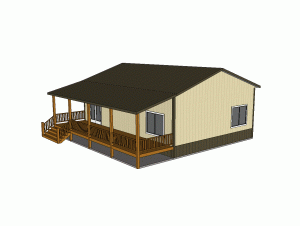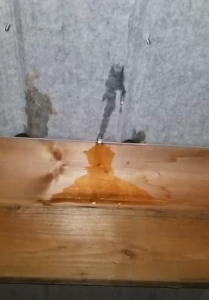For the most part, obtaining a building permit for a pole barn, or a waiver of the need to obtain one, is very easy. In my humble opinion, far too easy. The reality is… code enforcement agencies generally do NOT require engineering design documents for pole buildings.
Pole buildings are highly stressed, structurally indeterminate structures which mostly rely on wall coverings (wood or metal sheathing) for stability. Even a simple building has a minimum of ten connections and structural elements which require structural analysis to ensure building code compliance.
Among the elements which should be checked are the building columns (posts), the post embedment, the post footing, connection of the trusses to the columns, roof purlins, wall girts, roof and wall sheathing, and the lateral bracing system.
The engineering design analysis of a pole building is closer to an airplane, than a stud framed building. In our case, even a simple, rectangular pole building permit submittal requires seven or eight 24” x 36” blueprint sheets as well as over 100 pages of calculations.
There is no prescriptive building code for pole buildings, much due to the wide range of possible design solutions, as well as the numerous types of buildings which can be built using post frame. Unlike stick frame buildings, where studs are placed every 16 or 24 inches, pole barns can have structural columns anywhere from four to even 20 feet on center! Building Officials and Plans Examiners are hired to ensure building code compliance and, thereby, public health, safety and welfare. While it seems reasonable for engineering documentation to be required for pole buildings, more often than not, this is not the case. In reality, more than a few code enforcement officers and Building Departments are assisting unknowing clients to circumvent the building code.
Some jurisdictions actually hand out design documents whereby non-compliant, unsafe buildings are allowed to be permitted and constructed! Under structural analysis, these “prescriptive” requirements include overstresses of two, three or even four times the design loads. If an engineer would provide designs such as these, the engineer would lose his (or her) registration!
Non-engineered buildings fall down at an alarming rate. Even a little sprinkle of snow causes failures such as buildings collapsing under less than half the local design snow load. Supposedly this is deemed to be an “Act of God”. In reality, it is building contractors and Building Departments doing less than due diligence.
I heard a story recently about a woman whose building had blown over in a little puff of breeze the day after the contractor left the building site. The woman owned two acres and a llama. The Building Department had done her a favor and given her an Ag Permit. The Ag Permit saved her money and kept her from having to comply with the Building Code. It also kept her out of the “clutches” of the engineers. Some favor. She had absolutely no recourse. The disheartening thing is the collapse could have been prevented by the installation of a few pieces of pressure treated wood the contractor left behind in the scrap pile.
Nearly every state does not enforce the Building Code for all pole buildings. Much of the thought process is, “It’s just a pole building, who cares?” We should all care. When buildings fail, insurance companies pay and premiums go up. I care because under designed non-engineered building failures make it tougher on those of us who do use prudent engineering designs.
In most cases, engineering adds little or nothing to the cost of the overall structures. Engineers are able to eliminate redundant components, which add nothing but take dollars out of the building owner’s pocket.
If you are told your new building is permit or code exempt, a permit will be issued without a thorough structural review, or no engineered drawings are required, you should question as to why? In the end, the life you save…just may be your own.










That’s interesting that pole buildings don’t have the same code requirements as other construction. I guess that makes it important to hire a trusted contractor for a project like that. I’ve been thinking about a pole barn to get some extra storage on my property.
Actually post frame (pole) buildings have the exact same code requirements as any other structure when it comes to the design wind, snow and seismic loads – the problem comes when Building Officials choose to not hold suppliers and builders to the same level of accountability, or the jurisdiction either does not issue permits for any structure, or exempts pole buildings.
Those “trusted contractors” you mention? I can think of at least one very trusted major contractor who, when building permits are not required or are loosely enforced designs their buildings to what they refer to as “robust”, however they do not engineer out to meet what should be the design loads.
The true solution – in my humble opinion – is to only order a building from someone who can provide engineer sealed plans and calculations for a structure which EXACTLY matches what you intend to build or have built.
I thought it was really interesting how the article mentions that although pole barns don’t need certain codes to be built, it is still wise to look to an experienced builder for help. And the fact the article mentions about how much of the stability in the structure relies on wall coverings makes it seem like a task to be handled only by professional. I mean, if you’re going to do it, you might as well have it done the right way and get a professional to handle the project.
Basically, as your article suggested, construction permits are quite great as they will be able to provide safety for the ones who are going to use the building once it’s built. That is why it’s important to keep in mind this at all times even if you find it unnecessary. Personally, that is something I love to hear as there’s nothing more worth keeping in mind as with safety. Thanks for the informative article about building codes and the importance of permits!
Thanks Vivian! Our mission is to “Provide the Ultimate Post Frame Experience!” Part of that is to provide a safe, code conforming structure that will outlast the original builder. We understand the value in building to meet the inherent climactic demands put upon buildings throughout out great nation, and that these requirements are necessary to protect the safety of the owner or occupants.
Thanks for following!
PBG
I have a 17 year old pole building that we used to use for our animals and now we use it for storage. The county is telling me I have to permit it since it is not 100% agriculture. So I hired and engineer, who said it was very structurally sound, and he said it was perfect if the footings were 4’8″ on a cement pad. I dug, they are 3′ on their cement pad. Now what do I need to do to jump through my counties hoops?
Your engineer can design a fix for your shallow embedment.